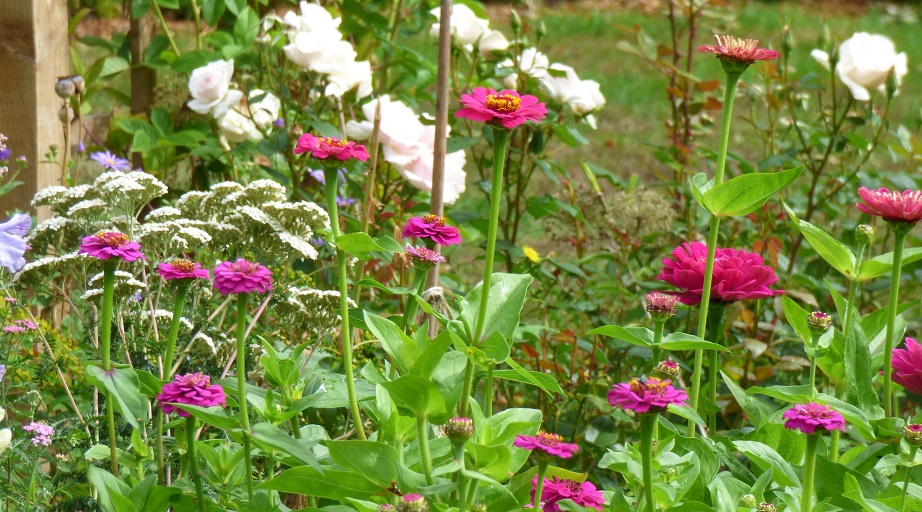One flowering annual that has thoroughly enjoyed the hot weather this year has been the Zinna. Whereas the Dahlias appear to have been delayed this year the Zinnias have produced tall, strong, clean plants with masses of excellent quality flowers.

I must admit that in previous years my Zinnas have struggled and if you get a cool period they just seem to sulk. In order to try and improve their chances in the future, even in cooler years, here are a few things to consider.
- Grown from seed Zinnia will germinate in 3-5 days at 27-29°C and 5-7 days at 21-24°C.¹
- The seedlings should be grown on with night time temperatures of 15-18°C and day time temperatures of 21°C.¹
- Zinnas dislike root disturbance so ideally the seeds should be sown in individual modules to reduce disturbance at the planting out stage.
- Plant out at a spacing of around 6 inches apart. The denser the spacing the taller the plants.¹
- Zinnas are quantitative short day plants (see How plants use day length to decide when to flower (Photoperiodism) ). This means that they flower more rapidly under short days but eventually flower regardless of photoperiod. Long days (greater than 12 hours) produce longer stems but delay flowering. Similarly if you plant a succession of Zinnas after the longest day they will flower on shorter stems.¹
- Benzakein⁴ emphasises the importance of pinching out the central flower bud when the plants are 18 inches tall to encourage the development of lower branches on the plant.
- Zinnas do seem to be prone to powdery mildew particularly if growing in conditions where hot days are followed by cool damp nights. Over watering can cause similar problems.
- If you are growing for cutting, pick the flowers before the pollen matures. If you can see fluffy, mature pollen the chances are the bees have done their job and the flower is now redundant and will wither to allow the seed to develop.
- There seems to be a difference in view as to whether Zinnas like ‘flower food’ or not. Beutler² states very clearly that they do not like floral preservative whilst Benzakein⁴ is an advocate of its use with Zinnas.
- Zinnas are long lasting in water but will wilt rapidly out of water and it is reported that they do not work well in corsages and buttonholes.²
In reality there is little that many of us can do about the great British weather and in some years different species will grow better than others. Certainly Zinnas like it hot and starting to grow the seeds too early if you don’t have the facilities to keep them warm can reduce your chances of success.

Keep in mind that Zinnia elegans is a warm-hot climate plant native to Mexico growing in scrub and dry grassland. Not every year will be suitable for them here in the UK but their bright vivid colours in late summer are certainly striking when conditions are right.
Half Hardy Annual
Origin: Mexico
Height: 60-90cm
Flowering period: July to October
Latin name: Zinnia elegans (after botanist Johann Gottfried Zinn (1727-1759)) ¹
Family: Asteraceae (Tribe: Heliantheae – Sunflowers)
Further reading
¹ “Specialty Cut Flowers” by Armitage and Laushman (ISBN: 0-88192-579-9)
² “Garden to Vase” by Linda Beutler (ISBN: 978-0-88192-825-9)
³ “The Cutting Garden” by Sarah Raven (ISBN: 978-0-7112-3465-9)
⁴ “Cut Flower Garden” by Erin Benzakein and Julie Chai (ISBN: 978-1-4521-4576-1)

Thank you for such an informative post! I have grown two varieties this year (Queen Red Lime and Cupid Mixture) and have really enjoyed them. I will definitely be trying more. The Benary series have caught my eye…
LikeLiked by 1 person